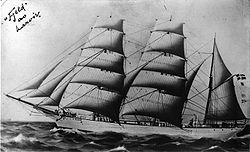Elissa (ship)
|
The ship as fjeld
|
||||||||||||||||
|
||||||||||||||||
|
||||||||||||||||
|
||||||||||||||||
The Elissa is a barque (sailing ship) built in Scotland in 1877 and is now a museum ship in The Seaport Museum in the United States .
history
Active service time
The ship was launched on October 27, 1877 for the Liverpool shipowner Henry Fowler Watt as Elissa at the shipyard Alexander Hall & Company in Aberdeen, Scotland. Watt operated the ship until 1897 and then sold it to the Norwegian shipping company Bugge & Olsen, which renamed the sailor Fjeld . After being sold to Sweden in 1911, the Fjeld was sold to Carl Johansson from Kalmar in 1912, who renamed it Gustaf . At the end of the First World War, the Gustaf was re- rigged to become a barquentine and fitted with its first engine. The Gustaf was not passed on again until 1930 , this time to Finland. The new owners have the ship re-rigged to a schooner and in 1936 a new engine installed, a new deckhouse with a bridge attached to the quarterdeck and the stem shortened. In 1959 the Gustaf found new Greek owners who gave her the name Christophoros . Two years later the naval archaeologist Peter Throckmorton discovered the ship in Piraeus. In 1964, Karl Kortum of the San Francisco Maritime Museum took the first steps to save the ship. After the Christophoros was renamed Achaeos in 1967 and Pioneer in 1969 , Throckmorton Kortum received permission to purchase the ship for the San Francisco Maritime Museum.
As a museum ship
In November 1970, the museum acquired the Pioneer for $ 14,000. Two years later, David Groos from Victoria, British Columbia bought the sailor for a Canadian group before going to the Galveston Historical Foundation for $ 40,000 in 1975. In 1977 a restoration team travels to Piraeus to make the ship that had been given the name Elissa back seaworthy. After about a quarter of her iron hull had been replaced and re-fitted with a clipper stem, the Elissa began a towing trip to Gibraltar in 1978, where she lay at the Royal Navy shipyard for the winter of 1978-79. Also in 1978, the ship was added to the National Register of Historic Places - the first object to be outside of US jurisdiction. On July 20, 1979, the Elissa finally arrived in Galveston, where she was officially received on August 4 that year. On July 4, 1982, after the restoration was completed, the first sailing trip to the Gulf of Mexico was undertaken. In the period that followed, the ship made further voyages and received numerous awards for the successful restoration and the associated group of volunteers. Afterwards, further adjustments to more modern security standards were made. The Elissa has been a National Historic Landmark since 1991, and the Texas Seaport Museum opens in October of that year. In 2000 it was named one of America's Treasures by the National Trust for Historic Preservation, and on June 18, 2005, Texas Governor Rick Perry named the Elissa the Official Tall Ships of Texas.
literature
- Otmar Schäuffelen: The last great sailing ships . Verlag Delius Klasing, Bielefeld 1994, ISBN 3-7688-0860-2 , p. 331 .
Web links
- Official museum side of Elissa (English)
- The Elissa at Rhiw (English)
Coordinates: 29 ° 18 ′ 34.1 " N , 94 ° 47 ′ 37" W.
